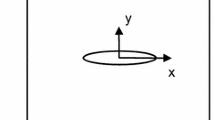Abstract
An appropriate coupled cohesive law for predicting the mixed mode failure is established by combining normal separation and tangential separation of surfaces in the cohesive zone model (CZM) and the cohesive element method. The Xu-Needleman exponential cohesive law with the fully shear failure mechanism is one of the most popular models. Based on the proposed consistently coupled rule/principle, the Xu-Needleman law with the fully shear failure mechanism is proved to be a non-consistently coupled cohesive law by analyzing the surface separation work. It is shown that the Xu-Needleman law is only valid in the mixed mode fracture when the normal separation work equals the tangential separation work. Based on the consistently coupled principle and the modification of the Xu-Needleman law, a consistently coupled cohesive (CCC) law is given. It is shown that the proposed CCC law has already overcome the non-consistency defect of the Xu-Needleman law with great promise in mixed mode analyses.
Similar content being viewed by others
Abbreviations
- ϕ n, ϕ t :
-
separation work
- q :
-
coupling parameter of work
- r :
-
coupling parameter of opening
- D n,D t :
-
damage level factors
- H n,H t :
-
integrity residual factors
- W n ,W t :
-
separation work
- δ n , δ t :
-
characteristic opening
- Δn,Δt :
-
opening displacements
References
Barenblatt, G. I. The formation of equilibrium cracks during brittle fracture, general ideas and hypotheses, axially-symmetric cracks. Journal of Applied Mathematics and Mechanics, 23(3), 622–636 (1959)
Dugdale, D. S. Yielding of steel sheets containing slits. Journal of the Mechanics and Physics of Solids, 8(2), 100–104 (1960)
Rose, J. H., Ferrante, J., and Smith, J. R. Universal binding energy curves for metals and bimetallic interfaces. Physical Review Letters, 49(7), 675–678 (1981)
Needleman, A. A continuum model for void nucleation by inclusion debonding. Journal of Applied Mechanics, 54(3), 525–531 (1987)
Tvergaard, V. and Hutchinson, J. W. The relation between crack growth resistance and fracture process parameters in elastic-plastic solids. Journal of the Mechanics and Physics of Solids, 40(6), 1377–1397 (1992)
Xu, X. P. and Needleman, A. Numerical simulations of fast crack-growth in brittle solids. Journal of the Mechanics and Physics of Solids, 42(9), 1397–1434 (1994)
Park, K., Paulino, G. H., and Roesler, J. Cohesive fracture model for functionally graded fiber reinforced concrete. Cement and Concrete Research, 40(6), 956–965 (2010)
Park, K., Paulino, G. H., and Roesler, J. A unified potential-based cohesive model of mixed-mode fracture. Journal of the Mechanics and Physics of Solids, 57(6), 891–908 (2009)
Gao, H. and Ji, B. Modeling fracture in nanomaterials via a virtual internal bond method. Engineering Fracture Mechanics, 70(14), 1777–1791 (2003)
Gao, H. and Klein, P. Numerical simulation of crack growth in an isotropic solid with randomized internal cohesive bonds. Journal of the Mechanics and Physics of Solids, 42(2), 187–218 (1998)
Klein, P. and Gao, H. Crack nucleation and growth as strain localization in a virtual-bond continuum. Engineering Fracture Mechanics, 61(1), 21–48 (1998)
Zhu, Y., Liechti, K. M., and Ravi-Chandar, K. Direct extraction of rate-dependent tractionseparation laws for polyurea/steel interfaces. International Journal of Solids and Structures, 46(1), 31–51 (2009)
Tvergaard, V. Effect of fiber debonding in a Whisker-reinforced metal. Material Science and Engineering: A, 125(2), 203–213 (1990)
Xu, X. P. and Needleman, A. Void nucleation by inclusion debonding in a crystal matrix. Modeling and Simulation in Materials Science and Engineering, 1(2), 111–132 (1993)
Beltz, G. and Rice, J. R. Modelling the deformation of crystallince solides. Proceedings of a Symposium Held at the Annual Meeting of the Minerals, Metals and Materials Society (eds. Lowe, T. C., Rollet, A. D., and Follansbee, P. S.), TMS, Warrendale, 457–480 (1991)
Rahulkumar, P., Bennison, S. J., Saigal, S., and Jagota, A. Cohesive element modeling of viscoelastic fracture: application to peel testing of polymers. International Journal of Solids and Structures, 37(13), 1873–1897 (2000)
Araki, W., Nemoto, K., Adachi, T., and Yamaji, A. Fracture toughness for mixed mode I/II of epoxy resin. Acta Materialia, 53(3), 869–875 (2005)
Author information
Authors and Affiliations
Corresponding author
Additional information
Project supported by the National Natural Science Foundation of China (Nos. 50878117 and 51038006), the China Scholarship Council Project (No. M. H. HE-2009621076), and the Tsinghua University Initiative Scientific Research Program (No. 20101081766)
Rights and permissions
About this article
Cite this article
He, Mh., Xin, Kg. Separation work analysis of cohesive law and consistently coupled cohesive law. Appl. Math. Mech.-Engl. Ed. 32, 1437–1446 (2011). https://doi.org/10.1007/s10483-011-1513-x
Received:
Revised:
Published:
Issue Date:
DOI: https://doi.org/10.1007/s10483-011-1513-x
Key words
- cohesive element
- cohesive zone model (CZM)
- cohesive law
- separation work analysis
- consistently coupled rule/principle
- consistently coupled cohesive (CCC) law
- non-consistently coupled cohesive law




